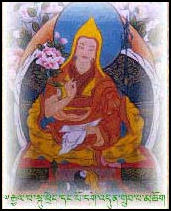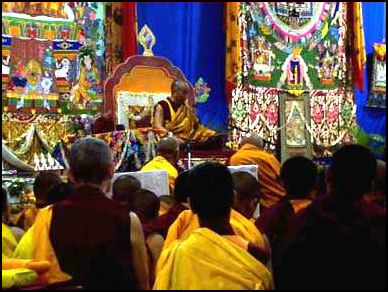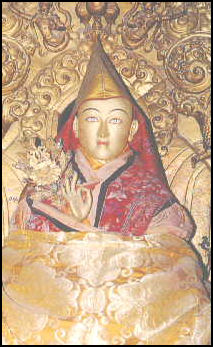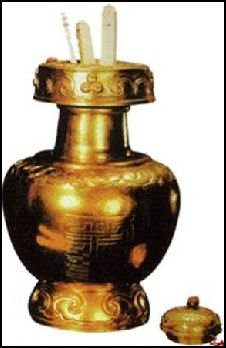DALAI LAMAS

Fifth Dalai Lama The Dalai Lama is the head of the Gelugpa (Yellow Hat) sect, the largest of Tibetan Buddhist school. He is revered as the reincarnation of all his predecessors and an incarnation of Chenrezig (Avalokiteshvara), the Bodhisattva of Compassion, and the Buddha. The Dalai Lama's full name is Jamphel Ngawang Lobsang Yeshi Tenzin Gyatso — Holy Lord, Gentle Lord, Eloquent, Compassionate, Learned defender of the Faith, Ocean of Wisdom. Among the other names he is known by are the Absolute Wisdom, the Living Buddha, the Holy One, the Defender of the Faith, the Ocean, the Excellent Understanding, Kundun ("The Presence"), the Mighty of Speech and the God-King.
The title of Dalai Lama is not passed down from father to son. The present Dalai Lama is not related to the Dalai Lama that preceded him, but rather is believed to be the repository of a spirit that resided in his predecessor and the Dalai Lamas that preceded him. Because the Dalai Lama is a reincarnation, no family dynasty was established. Chenresig is a a deity who has chosen to remain on earth to help people achieve enlightenment.
Dalai is the Mongolian word for “ocean.” Lama is a Tibetan word for monk. “The title "Dalai Lama" is not normally used by Tibetans among themselves. They prefer terms as "Precious Protector" or "Precious Ruler," of Kundun (Presence), implying spiritual association. While the press like to refer to the Dalai Lama as a "Living God” or “God-King” Tibetans view him more in human terms despite their deep reverence for him and regard him more as a “Monk-King” or “Philosopher King.” The first Dalai Lama was Tsong Ka-pa, born in Am-do in 1358. His disciples became the Yellow Hat sect, as distinct from the earlier priesthood of the Red Hats. The first Dalai Lama to bear the title was the 3rd Dalai Lama, Sonam Gyatso. (The two previous incarnations were named "Dalai Lama" after their deaths.)
Websites and Sources: Official Dalai Lama site dalailama.com ; Early Dalai Lamas minnesota.publicradio.org ; Dharamsala (Home of Dalai Lama ) site mcllo.com ; Wikipedia article Wikipedia ; Dalai Lama Quotes brainyquote.com ; Dalai Lama Foundation dalailamafoundation.org ; Nobel Prize Biography /nobelprize.org ; Tibet: Central Tibetan Administration (Tibetan government in Exile) www.tibet.com ; Chinese Government Tibet website eng.tibet.cn/; Wikipedia article on Tibet Wikipedia ; Wikipedia article on Tibetan History Wikipedia ; Tibetan News site phayul.com ; Tibet Activist Groups: Free Tibet freetibet.org ; Tibetan Centre for Human Rights and Democracy tchrd.org ; Friends of Tibet friendsoftibet.org Tibetan Studies and Tibet Research: Tibetan Resources on The Web (Columbia University C.V. Starr East Asian Library ) columbia.edu ; Tibetan and Himalayan Library thlib.org Digital Himalaya ; digitalhimalaya.com ; Center for Research of Tibet case.edu ; Tibetan Studies resources blog tibetan-studies-resources.blogspot.com
See Separate Articles PRESENT DALAI LAMA Factsanddetails.com/China ; DALAI LAMA’s CURRENT LIFE Factsanddetails.com/China ; DALAI LAMA AND POLITICS Factsanddetails.com/China ; PANCHEN LAMAS AND LAMA CONTROVERSIES Factsanddetails.com/China ;KARMAPA LAMA Factsanddetails.com/China
RECOMMENDED BOOKS: Dalai Lamas: “Secret Lives of the Dalai Lama: The Untold Story of the Holy Men Who Shaped Tibet, from Pre-history to the Present Day” by Alexander Norman (Author), Dalai Lama Amazon.com; “The Fourteen Dalai Lamas: A Sacred Legacy of Reincarnation” by Glenn H. Mullin , Valerie Shepherd, et al. Amazon.com; “The Dalai Lama and the Emperor of China: A Political History of the Tibetan Institution of Reincarnation” by Peter Schwieger Amazon.com; “The Illusive Play: The Autobiography of the Fifth Dalai Lama” by Samten Gyaltsen Karmay Amazon.com; “Path of the Bodhisattva Warrior: The Life and Teachings of the Thirteenth Dalai Lama” by Glenn H. Mullin Amazon.com; “The Hidden Life of the Sixth Dalai Lama” by Simon Wickham-Smith Amazon.com; 14th Dalai Lama: “Freedom in Exile: The Autobiography of The Dalai Lama” by Dalai Lama Amazon.com; “The Dalai Lama: An Extraordinary Life” by Alexander Norman Amazon.com; “The Story of Tibet: Conversations with the Dalai Lama” by Thomas Laird Amazon.com
Tibetan Buddhism, Reincarnation and Lamas
It is believed that when a lama dies, his spirits move into a new body. After his death a search for the individual that possesses this body begins. In theory, the search for a new lama is supposed to be based on visions from oracles, divine messages and poems and messages left from the previous lama. In reality, the search process is often affected by politics, court intrigues and factional infighting.
A reincarnation of a lama is called a "tukla." He is regarded as a sacred vessel of Tibetan Buddhism. Describing what they look for in a new lama one senior lama in Mongolia told National Geographic, "They are watched for certain qualities. They must, for example, have beautiful hands, because they must make certain hand movements."
According to the National Palace Museum, Taipei: The different schools of Tibetan Buddhism each developed a system of reincarnation lineage, and the reincarnated spiritual teacher is known as tulku in Tibetan and huofo (living Buddha) in the Chinese world The tulku tradition, non-existent in either India or China, was gradually established in Tibet over the course of hundreds of years. In the two primary periods of the development of Tibetan Buddhism, the snga dar (earlier dissemination) of the 7th-9th century and the phyi dar (later dissemination) revival in the late 10th century, leadership was transmitted from teachers to disciples or through family bloodlines at all monasteries. In the 13th century, the Karma Kagyu School became the first to adopt the reincarnation system, and by the 15th century the practice had spread to other schools. Today, it is one of the main forms of lineage in Tibetan Buddhism. [Source: National Palace Museum, Taipei, npm.gov.tw]
See Separate Article TIBETAN BUDDHIST LAMAS factsanddetails.com
History of the Dalai Lama
According to the National Palace Museum, Taipei: In the 15th century, Tsongkhapa (1357-1419) founded the Gelug School, and its lineage was in the early days passed from masters to disciples. Two disciples of Tsongkhapa, Gedun Drupa (1391-1474) and Kedrup Je (1385–1438), were posthumously identified as the First Dalai Lama and the First Panchen Erdeni, respectively, which became the two foremost living Buddha lineages in the Gelug School. The title Dalai, the Mongolian word for "ocean," was bestowed upon the Third Dalai Lama by the Mongolian ruler Altan Khan (1507-1582) of the Tumed. The Qing dynasty saw nine Dalai Lamas, from the fifth to the thirteenth.
Zhang Juzheng served as Senior Grand Secretary in the first decade of the Wanli Emperor's reign (1572-1620) in the Ming dynasty. In his "Memorial on Mongolian Request to Present Tributes," Zhang wrote that the Tibetan monk Sonam Gyatsho (1543-1588) was hailed as a huofo by Tumed leader Altan Khan (1507-1582). This is the first time the term huofo appears in Ming official documents, but it is likely a translation of the Mongolian word rather than formal nomenclature.
Altan Khan invited Sonam Gyatsho to Qinghai to teach in the 5th year of the Wanli reign (1577) and bestowed upon him the title "Dalai." Since then, he had become known as the Third Dalai Lama, and his two predecessors were posthumously recognized as the First and the Second Dalai Lamas. In the following year (1578), the Third Dalai Lama sent tributes to the Ming court and wrote to Zhang Juzheng, which is documented in Mingshi (The Official History of the Ming Dynasty).
Past Dalai Lamas

First Dalai Lama
There have been 14 Dalai Lamas. The first, a nephew of Tsongkhapa, the founder of Tibetan Buddhism, was born in 1351 and was a shepherd. The title of Dalai was first bestowed on the 3rd Dalai Lama by a Mongol chief named Altan Khan when the Dalai Lama visited the court of the Mongol Khans in the 16th century.
As has been the case with kings and world leaders, there have been good Dalai Lamas and bad ones and ones whose lives have ended in tragedy. Many died young , including the 9th, 10th, 11th and 12th Dalai Lamas. Some were rumored to have been poisoned. Others were believed to have been murdered. Only half of the men who held the title have lived to see their thirties. At least four are believed to have been killed amid palace intrigue. In 1682, a government minister hid the death of the Dalai Lama for fifteen years, secretly ruling with the help of a look-alike.
One of the worst was the 6th Dalai Lama, Tsangyang Gyatso (1683-1706), who was more interested in women and alcohol than he was in studying and leading. He used to sneak out of Potala in disguise to visit local brothels. A Jesuit monk who lived Lhasa as the time of his leadership wrote that “no good-looking person of either sex was safe from his unbridled licentiousness.” His ineptitude gave China an excuse to intercede in Tibetan affairs. The sixth Dalai Lama, was a poet whose love songs in Tibetan verse are much beloved among Tibetans and Han alike. His writing is considered by some to be part of the Chinese literary tradition. This is ironic considering he was kidnapped and deposed in a series of murky events, possibly with the consent of Qing Dynasty Chinese Emperor Kangxi (See Below). [Source: Bruce Humes, Ethnic ChinaLit, December 17, 2014]
The 13th Dalai Lama barely escaped an assassination attempt allegedly orchestrated by his own regent. He recognized Tibet’s backwardness made it vulnerable to aggression by more advanced nations of the world. His plans to improve and reform the Tibetan bureaucracy and military were thwarted by the monastic elite.
Fifth Dalai Lama
The 5th Dalai Lama is credited with uniting the warlike medieval tribes of Tibet. In 1642, he became the political and spiritual leader of all Tibet. He is often referred to simply as the Great Fifth, being a key religious and temporal leader of Tibetan Buddhism and Tibet. He was something of a Renaissance Man, who wrote 24 volumes' worth of scholarly and religious works on a wide range of subjects, and is said to have enjoyed himself. He is still greatly loved and revered today.
Although the leader of the Gelug School, the Fifth Dalai Lama ((1617-1682) also supported the Nyingma School and was known for his ties to the Nyingma lineage. Nyingma literally means "ancient" and was Tibetan Buddhism first school. The Fourth Panchen (1567-1662) was the Fifth Dalai Lama's right hand. The Fifth Dalai Lama was identified by the Fourth Panchen, who was his most important mentor and played a key role in his rise to power. . During the period of the fifth Dalai Lama (1642-1682), lamas from all over the country were brought to Potala Palace to systematically study and coordinate the knowledge of traditional Tibetan medicine and other subjects. [Source: National Palace Museum, Taipei, npm.gov.tw]
In 1642 in the Ming dynasty, the Fifth Dalai Lama allied with Güshi Khan (1582-1655), leader of the Khoshut Mongols, and ended the division in Tibet by establishing the Gaden Phodrang, thus securing the political supremacy of the Gelug School. In 1650 in the Qing dynasty, the emperor (r. 1643-1661) invited to the Fifth Dalai Lama to visit Beijing. Two years later, the Dalai Lama arrived in the Qing capital and resided in the Xihuang Monastery that the emperor had built for him. In 1654,, the emperor conferred upon the Fifth Dalai Lama a gold seal, a gold album, and the title "Dalai Lama, Overseer of the Buddhist Faith on Earth under the Great Benevolent Self-subsisting Buddha of the Western Paradise." After that all Tibetan Buddhist high monks had to be confirmed by investiture by the Qing court.
Sangye Gyatso (1653-1705), regent of the Fifth Dalai Lama and ally of Galdan Khan, kept secret the death of the Fifth Dalai Lama in 1682 and for 15 years claimed that the religious leader was in retreat. The Kangxi emperor learned of the Fifth Dalai Lama's death in 1696 and was greatly irritated. Sangye Gyatso admitted the lie the next year and told the emperor that he had already selected the Sixth Dalai Lama (1683-?), asking the emperor to keep the secret until the Sixth Dalai Lama's installation. The emperor agreed.
Rule of a New Dalai Lama
The Dalai Lama is claimed as a living incarnation of the Divine Spirit, a position reached through a traditional search and testing. When a Dalai Lama departs from life, priests traditionally conduct a search for his successor through signs and visions. Selected children are tested by their ability to recognize objects belonging to the former Dalai Lama. After identification, the child is brought to the holy city of Lhasa and initiated as a monk in the monastery of the Potala, which becomes a power center of the Divine Spirit, which issues forth from the Dalai Lama over the whole of Tibet.
Typically, when the Dalai Lama dies, the royal court appoints a regent who rules until the next reincarnation comes of age. Over the centuries some regents grew fond of their power and some Dalai Lamas expired prematurely, not to mention suspiciously. The sense of the regency as a time of peril persists.” [Source: Michael Powell, New York Times, January 31, 2009]
In the past, the periods that followed the deaths of the Dalai Lama, when Tibet was governed by regents, were less stable, because the regents did not have the mandate of the Dalai Lama. Regents also often engaged in power struggles with rivals — stories of one lama poisoning or imprisoning another were not uncommon. [Source: Edward Wong, the New York Times, June 6 2009]
The atheist Chinese government has improbably insisted that it has the legal right to designate the Dalai Lama’s next reincarnation.
Activities of the Dalai Lama

Dalai Lama initiation
Traditionally, the Dalai Lama was not supposed to mix with ordinary Tibetans. Most of his time was spent inside his home, the 1,000-room Potala palace in Lhasa.
The Dalai Lama traditionally has kept the preserved corpse of his teacher in his palace. The present Dalai Lama keeps the plastic-coated body of his teacher Ling Rinpoche, who died in 1983, in his home in India.
The Dalai Lama’s main duties as religious leader have been to preside over important ceremonies and rituals and make decisions with the help of an oracle who goes into trances to communicate with spirits and predict the future.
In the old days, when the Dalai Lama left his palace, he was transported in a yellow silk sedan chair carried by 20 army officers in red hats. The Dalai Lama wrote in his autobiography that when he was carried around when he younger he was surrounded by an entourage of hundreds of men, including monks, musicians, swordsmen mounted on horses, "porters carrying my songbirds in cages and my personal belongings all wrapped in yellow silk," and monastic police carrying "long whips, which they would not hesitate to use" if people came too close.
The Dalai Lama has traditionally relied heavily on the "state oracle," a deity called Nechung, who communicates through a human medium, usually a monk.” According to the Dalai Lama's description in his memoir, the medium slips into a trance "with bulging eyes and swollen cheeks. . . . His breathing begins to shorten and he starts to hiss violently." The Dalai Lama poses questions, and the oracle responds with enigmatic advice. [Source: Evan Osnos, The New Yorker, October 4, 2010]
See Separate Article TIBETAN BUDDHIST BELIEFS: KALACHAKRA, SHAMBALA, TANTRISM AND ORACLES factsanddetails.com
Search for New Dalai Lama and the Golden Urn

Sixth Dalai Lama
In the event the Dalai Lama dies, there are provisions for the selection of a council of regents that would rule until a new Dali Lama is found. The next incarnation of the Dalai Lama is supposed to be born 49 days after the current Dalai Lama dies, but already a controversy has arisen over who the successor will be.
After a Dalai Lama dies a search begins for a successor, a "soul child" who has fulfilled certain prophecies and whose body shows certain signs that he has received the spirit of the departed Dalai Lama. The search is carried out by senior monks who travel the countryside on horseback after experiencing a divine vision while sitting beside a divine lake. The Panchen Lama is often involved in the process. The ninth Panchen Lama played an important role in the search for the 14th and current incarnation of the Dalai Lama in the 1930s. The Dalai Lama in turn was instrumental in identifying the 10th Panchen Lama in the 1950s.
In process of choosing a new Dalai Lama, the Dalai Lama’s closest aides look for divinations in the sacred lake. A mountain god transmits oracular messages by possessing a high lama. Monks scour villages for boys precocious in their spiritual attunement. [Source: Edward Wong, the New York Times, June 6 2009]
After the death of the 13th Dalai Lama in 1933, senior lamas journeyed on horseback to the sacred lake of Lhamo Lhatso, not far from Lhasa, the Tibetan capital. There, they said, they received a vision that pointed to eastern Tibet as the site where the reincarnation would be found. Earlier, a medium of the Nechung Oracle, the mountain god that serves as the state fortuneteller, was said to have turned eastward in a trance. [Source: Edward Wong, the New York Times, June 6 2009]
After a candidate had been selected — it can be a girl or a boy but usually it is a boy — he is questioned and asked to pick out the previous Dalai Lama's possessions from copies of the originals.
See Search for the Present Dalai Lama Under PRESENT DALAI LAMA Factsanddetails.com/China
History of the Dalai Lama Selection Process
According to the National Palace Museum, Taipei: In his annotations in a court manuscript the Qianlong emperor (r. 1736-1795) says, "The khubilghan means the reincarnated spirit. When the old khutuktu [high ranking lama] attains the state of nirvana, it is customary to select several extraordinary children from nearby tribes, and the one who knows the items belonging to the departed khutuktu is recognized as the successor to the khubilghan title." This passage is similar to what the emperor wrote in "Discourse on Lamas" in that it also interprets the khubilghan as a "reincarnated spirit." In the Qing dynasty, the term khutuktu (originally meaning "the blessed" in Mongolian) became a title for high-ranking living Buddhas in Mongolia and Tibet. Religious leaders of this level were all registered in the records of the Lifan Yuan (Board for the Administration of Outlying Regions) and every reincarnation must be reported to the Qing court for endorsement and investiture. [Source: National Palace Museum, Taipei, npm.gov.tw]
In the 8th month of the 57th year of the Qianlong reign (1792), following the expulsion of the invading Gurkhas in Rear Tibet by Qing troops, Emperor Qianlong put General-in-chief Fuk'anggan (1753-1796) in charge of subs equent negotiations and reforms of Tibetan administration. The result is summed up in the 29-article "Ordinance for the More Effective Governing of Tibet," with the first article stipulating the use of the "Golden Urn" scheme to select the khubilghan.
In the 4th month of the following year, the emperor published the article "Discourse on Lamas," which describes the history of the lamas and the reincarnation system. It also stresses the importance of "supporting the Yellow Sect in order to pacify the Mongols" and explains that the new Golden Urn scheme would "stabilize Tibet and surrounding domains and lead to everlasting peace in the country.
Golden Urn and the Selection of the New Dalai Lama
According to the regulations stipulated by the Qing government (1644-1911), the final step of confirmation of the reincarnation of the Dalai Lama is the "drawing of lots from a golden urn" ceremony. The Golden Urn was given as a present to Tibet in 1792 by the Chinese Emperor Qianlong, a pious Buddhist, as a way of selecting a Dalai Lama when there was a dispute involving several candidates. The Golden Urn is currently in the possession of Beijing and regarded as symbol of their authority over Tibet.
In the golden urn ceremony, the names of the soul boys that have made it this far are written on slips of paper and placed in silken purses, which are placed the special golden urn. Traditionally, the Resident Official of the Qing government in Tibet, in the presence of the representatives of Tibetan monks and laymen, drew one name. The soul boy whose name is drawn is then recommended to the Tibetan National Assembly, who vote on whether or not to approve the new Dalai Lama.
If he is approved, the new Dalai Lama is carried into Lhasa with much fanfare. He then undergoes rigorous religious training — which includes the study of philosophy, monastic discipline, metaphysics and logic — until he accedes to power at the age of 18. The problem with the system is that there is leadership vacuum of almost 20 years between the time one Dalai Lama dies and his successor comes to power. During this Tibet has traditionally been led by a regent
See Qing Dynasty, Dalai Lama and the Golden Urn Under 10TH TO 18TH CENTURY TIBET: FEUDALISM, BUDDHISM, CHINA, MONGOLS factsanddetails.com
New Proposals for Selecting a Dalai Lama

Golden urn
In November 2007, the Dalai Lama said that the Tibetan people will vote on a new system of leadership before he dies. Among the proposals on the table are getting rid of the Dalai Lama, choosing a new Dalai Lama outside of Tibet while the current Dalai Lama is still alive, holding an election of senior lamas sort of like the “college of cardinals” that selects the Pope and passing power to the next senior-most monk. The effort is a response to concerns that China will manipulate the current system to chose a leader it wants.
The Dalai Lama proposed a referendum on the issue in Tibet voted on by Tibetan Buddhists. If a majority rejects the referendum then the Dalai Lama would not be reborn and the institution of the Dalai Lama would come to an end, ending a tradition that dates back to the 14th century. If a majority supports the referendum then the Dalai Lama would likely appoint a new Dalai Lama while he was still alive.
The move came after the Chinese government introduced a new regulation in September 2007 that stated that no “living Buddha” can reincarnated without permission form the atheist Communist government and that “living Buddhas” are required to “respect and protect the principals of unification of the state.” The new regulations seems to have been passed to undermined the authority of the Dalai Lama and lamas loyal to him.
It is not clear how the referendum would be conducted. No doubt it will be impossible for Tibetans in Tibet and China to vote, which means the decision would be based on the opinions eight million Tibetan Buddhists that live outside of China, mostly in Nepal, Bhutan, India. Mongolia, Russia and the West. The proposal also puts the Chinese government in an unusual position of being the upholders of Tibetan Buddhist traditions.
The Dalai Lama has also proposed choosing his own successor. Selecting a reincarnation of oneself before one dies does not seem tp be an issue with most Tibetans. If the Dalai Lama were to do this it would shorten the period in which there was no Dalai Lama. Barnett said Tibetan Buddhism allows great flexibility in changing old systems.
See Separate Article AFTER THE DALAI LAMA DIES AND CHOOSING A NEW DALAI LAMA factsanddetails.com
Image Sources: 1) Purdue University, Columbia University, Dalai Lama com
Text Sources: New York Times, Washington Post, Los Angeles Times, Times of London, National Geographic, The New Yorker, Time, Newsweek, Reuters, AP, Lonely Planet Guides, Compton’s Encyclopedia and various books and other publications.
Last updated September 2022
